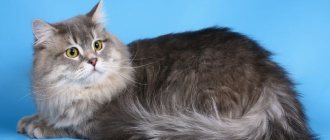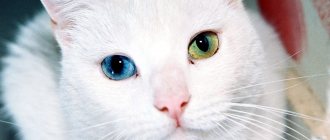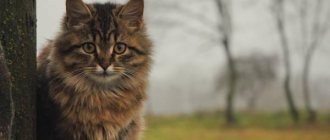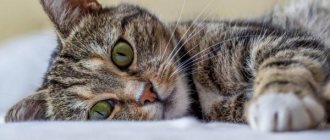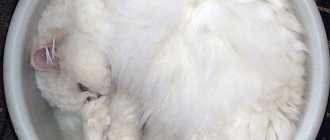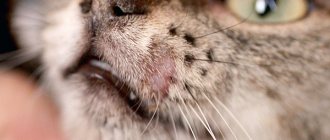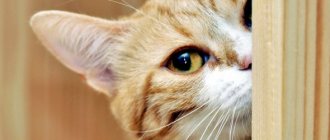Nature has endowed all cats with a difficult character, but black cats are also distinguished by their unusual appearance. People blame these animals for all misfortunes and superstitiously try not to cross them on the road.
Apparently, this is how the subconscious fear of the dizzying beauty of animals in shiny coal-colored coats is expressed. But this color in different combinations is found in almost all cat breeds.
Genetics of black color
The pigment pheomelanin is responsible for the red color, and eumelanin is responsible for the black color. In cat hair they are presented in the form of granules, the shape, quantity and location of which determine the color shade. Let’s leave the first one (red) aside, and consider the second one in detail.
- In black cat breeds, the B (black) gene is responsible for color. In the genotype of an animal, it can be represented in three alleles (species): dominant B, recessive b and bl.
- In the dominant state, the gene forms almost round (slightly elongated at the poles) eumelanin granules with a dense arrangement in the hairs. This gives a rich black color.
- The recessive allele b of the same gene stretches the pigment granules and moves them away from each other. It turns out to be a chocolate shade.
- The final form of bl is even more expanded eumelanin capsules and a sparse arrangement. On the hair this gives the color of cinnamon (cinnamon), characteristic of many breeds.
All other characteristics do not play a role in the color of interest - a large black cat is necessarily a carrier of the dominant B gene.
This is interesting! In black cats, there is no relationship between coat color and the sex of the animal. Their genes are not connected to the chromosomes that are responsible for dividing into “boys” and “girls.”
Historical facts
The Egyptians worshiped black cats; they considered them a deity and the most graceful and beautiful animal.
Animals began to be viewed negatively during the Middle Ages, when there were witch hunts. At that time, people believed that a witch should have a black pet as a talisman and that the witch could turn into cats.
In 1233, a decree was issued that black cats are the personification of the devil.
Black kittens were even exterminated en masse, as they were believed to be accomplices of Satan.
Nowadays, it is quite difficult to believe in fairy tales about witches, but people are wary of charcoal-colored cats.
Characteristic eye color
The genetics of the pupil is less studied than the properties of fur. Researchers suggest the presence of a color gene and some polygenes that are located outside the studied structures and affect the characteristic features of the organism.
Felinologists identify three most common combinations:
- Black cats with green (grn) eyes are a classic color combination.
- The second group is orange, brown and amber-honey (org) eyes.
- The final position is in the copper color range (cpr). Fairytale black cats with red eyes actually come from this category.
When recessive alleles (b, bl) come into play and various shades appear on the cat's coat, the pupil color combinations automatically dilate. But absolutely black cats have only the three listed eye colors.
This is interesting! Black coat color is never ideal. It all depends only on the degree of its saturation, which hides some natural pigmentation flaws.
Bombay cat: black standard breed
Bombays are short-haired black cats, fit, graceful, with shiny golden-copper eyes. Their coat has a glossy satin texture, it is evenly colored along the entire length of the hair and lies tightly to the body. The long tail makes the miniature animal look like a wild predator.
The selection was carried out in the USA, where felinologists pursued two goals. Firstly, this is the desire to consolidate the obligatory black color in hereditary characteristics. Secondly, they wanted to obtain an external resemblance to a panther.
The parent breeds were Burmese and representatives of the American Shorthair cat. It took 4 generations of kittens to breed to achieve a positive result.
Bombays are called the most beautiful black cats. Their color must be uniform from root to tip, and uncolored white patches are considered a serious reason for disqualification.
This is interesting! Bombay kittens are born with small spots and bright blue eyes. As they grow older, the animals change color, get rid of alien light patches on their coats, and the color of their eyes becomes golden.
Habitat and role of the African black-footed cat in the ecosystem
The small black-footed cat lives in the southern regions of the African continent in deserted open dry plains, in savannas and steppes with occasional thickets of low bushes and tufts of grass.
Traces of this animal were found in the following countries:
- SOUTH AFRICA;
- Angola;
- Namibia;
- Botswana;
- Zimbabwe.
In the wild, the black-footed cat lives in the dry desert regions of Africa.
There are two types of miniature predators living in different places:
- Felis nigripes thomasi - in Botswana (sparsely inhabited areas of the Kalahari Desert), distinguished by a more contrasting and darker fur color;
- Felis nigripes nigripes - in Namibia (Karoo plateau) in dry grassy areas, individuals of this species are smaller in size and their coat is paler.
Despite their miniature size, black-footed cats are important predators, having a significant impact on the population of rodents and various small mammals.
Breeds with acceptable black coloration
In nature, this color is not unique among cats and is often found in any breeding groups. The dominant B gene is stably present both in native breeds (which were formed under natural conditions) and in various hybrid communities or among outbred animals.
big black cats coexist with equally charcoal-shiny homeless strays, and this picture never surprises anyone.
American Bobtail
A rare breed of tailless cats. Their breeding began in the 60s in Arizona and continues to the present day. Among the parents of the American Bobtail are Siamese, Burmese, and Himalayan cats. A distinctive feature of the breed is the absence of a tail, and the color fades into the background.
More often than others, grey-red kittens with a tabby pattern (stripes and spots) are born. Fluffy black cats with a small overgrown tassel in place of the tail are less common, but it all depends on the parents and genetic predisposition.
The mixture of different breeds in the origin of the American Bobtail suggests the appearance of offspring of the most unusual colors, among which there are both solid black colors and combinations of black and white.
Siberian breed: black cat with green eyes
An indigenous Russian cat, which can be recognized as a national treasure of the country. The history of origin is unknown for certain, like most other breeds. But rich long fur, dense undercoat and adaptability to harsh climates indicate that the animal has perfectly adapted to its natural habitat.
The solid colors of Siberians come in two colors: red and black. But if the red tones are intersected by a tabby pattern (stripes, spots or blurred marble), then the coat of a long-haired black cat looks very impressive. In total there are more than 200 combined color options.
This is interesting! Siberian cats became the founders of the Neva Masquerade subspecies - a long-haired breed with a characteristic point mask in red or black shades.
Oriental cat
Oriental cats are champions among black breeds in terms of gracefulness. They are very graceful and sophisticated, on high slender legs, with an elongated wedge-shaped muzzle on a long neck and slightly slanting green eyes. In this color, the wool is evenly dyed along the entire length, from the root to the end.
Among representatives of this species, smooth-haired black cats are also often found.
Devon Rex
Devon Rexes are presented in two categories:
- Like many new breeds that gained official recognition in the 20th century, all modern Devons are descended from a kitten found in the litter of a mongrel cat. He had very large ears and curled fur, for these qualities the cat received the name Kirli (curly).
- It is a rare case when literally everything is known about the first animal in the group - Kirli was a black cat with eyes the shade of yellow amber.
Devons are very active pets - they love to climb onto the owner's neck and sit on his shoulders.
Like other representatives of the “eared” group, they are often called elves, hinting at “extraterrestrial” genetics. Among the popular black cat breeds, Devon cats are not considered. The population is small and black is not the most common color.
Turkish Angora
For more than a century, Turkey has had a program to preserve this breed as a national treasure. We are talking about a classic Angora cat with long or semi-long white hair and multi-colored eyes - yellow and green.
These animals began to be called Angora due to their very soft hair, by analogy with the well-known downy goat breed.
The spread around the world and the efforts of breeders have not benefited the classic white color. It is gradually giving way to other colors, and it is not surprising when black-brown cats with different-colored eyes and a fluffy long tail appear at exhibitions.
It must be admitted that in the pure black version, the shaggy Turkish Angora looks very impressive and rich.
Norwegian forest
Representatives of the aboriginal breed live in Northern Europe. One of the legends about its appearance connects the harsh, unpretentious Norwegians with the pampered southern Angora breed, which has adapted to living conditions in a cold climate.
The forest cat is large, with a double coat, dense undercoat and winter “decorations”: a mane, bib, whiskers and warm pants on the hind legs.
The portrait is completed by neat erect ears with tassels and thick pubescence on the inside of the auricle.
Norwegians are large animals that mature only at 4-5 years of age. Any color is allowed in the breed except those that indicate an undesirable crossbreed: fawn, cinnamon, chocolate and others. Large all-black cats are rare, but black and white cats with thick undercoat are common.
This is interesting! The indigenous qualities of the Norwegian forest cat are protected by an international association. Their out-of-breed crossings are allowed only with a separate permission from WCF.
American Curl
There are representatives of this breed with semi-long and short hair. A distinctive feature of Curls are their ears - wide at the base, semicircular at the top, with reverse folded ears at an angle of at least 90°.
There are no separate requirements for coat and eye color, with the exception of color-point colors with a characteristic blue eye color. In other colors, shades from brown to light hazel are acceptable.
Representatives of this breed with pure black hair are rare. The most beautiful black cats are the offspring of short-haired parents. Long-haired pets are traditionally presented in black and white.
Important! The American Curl should not be left alone with small children. Careless caresses can damage the fragile structure of the curled ears.
Manx
The main distinguishing feature of the Manx cat is the absence of a tail. The length of what is left of it cannot extend below the hock joint of the hind legs. But more often there are animals with a 3-7 cm “process”.
When breeding animals, they must select one of the parents with a longer tail - two tailless genes lead to the death of the offspring.
Manx cats are allowed any coat color, except for the color-point varieties. Black kittens are rare, but white or tortoiseshell cats are born consistently.
Cymric
The Cimmerian breed is a semi-longhaired version of the Manx. Breeders united kittens with long hair into a separate group, and then they were recognized by international felinological unions.
Black tailless Cymric cats are born with yellow or green eyes and the typical short "broom" for a tail. They easily adapt to the family and get along well with children and pets.
Coal Bengal
To call this cat black is wrong, but to describe it in any other way is stupid. Bengals are an interspecies mix. Their ancestors are domestic cats and wild Bengal cats. The hybrid received an incredibly beautiful spotted color - contrasting black spots on a golden background.
In appearance, they resemble small leopards with a cute face and an independent character.
The Charcoal Bengal's main coat color is bleached black, and the spots and stripes are less pronounced. Another feature of the animal’s appearance is the mask on its face. Its lines are wider than those of standard-colored cats.
Charcoal Bengal charcoals do not have any privileges in the standard and are subject to general expert rules.
Chausie
Another hybrid of a domestic cat (this time an Abyssinian) and a wild jungle cat. The desire to breed a harmless animal with the external signs of a predatory animal does not leave breeders, and they are finding more and more sophisticated ways. Chausie (housey) is another experiment in this chain.
This breed has only three colors:
- silver;
- tabby;
- black.
It is not recommended to keep Chausies in an apartment, as they need space to play and move.
Description of the black-footed cat
The animals are small in size, which allows them to remain invisible to potential prey. Body length in adult females averages 30–36 cm and tail length 15 cm, and weight ranges from 1.0 to 1.4 kg. Cats are larger and heavier, as befits men: the overall dimensions are 55–62 cm and the maximum weight reaches 2.0 kg. Shoulder height is no more than a quarter of a meter.
External features
Black-footed cats have a wide head with prominent, rounded ears. There are two dark lines on the cheeks. The eyes are yellow and glow blue in the dark. The edges of the mouth are white. There are ring-shaped markings on the throat. The main coat color is pale red in the northern part of the range and red-brown in the south. The hairs are 25–30 mm long. There are spots in rows on the sides and chest. There are black transverse stripes on the limbs. The belly and inner sides of the legs are light. The surface of the skin is pink, without areas of any pigmentation.
It turns out that the adult individual has an unusual shape of teeth: the ends of the upper fangs are curved inwards in a hook and are sharp, like blades. Once in the predator's mouth, the victim immediately receives a mortal wound.
The tail is short, less than half the length of the body and head, with a black pointed tip and dark rings, incomplete at the base. Thick fur grows on the paw pads, which allows the animal to walk on hot sand. This unique “sole” also protects from the cold during frost periods.
Adult females of Felis nigripes are the smallest wild cats in the world
Character
A wild cat with dark paws is a cautious animal. Therefore, it very rarely falls into the lenses of camouflaged cameras. Taken by surprise, it raises its fur and spreads its ears to the sides, showing the enemy that it will defend itself. In moments of danger, she behaves boldly and confronts even the black-backed jackal, which is 8 times her size.
The Bushmen tribes tell a legend that an angry animal jumped onto the back of a giraffe’s neck and tried to drop it to the ground. Of course, this is fiction, although plausible. One of the scientists actually saw a wild cat attempt to attack an ostrich. Of course, it was unsuccessful. But sinking fangs into the neck of a victim equal in weight or slightly heavier is quite common.
The hunting tactics of the black-footed cat show its excellent learning abilities. Zoologists suggest that initial skills are passed on to young people by the older generation, and then the art of getting food is improved through personal experience. A sudden jump or long pursuit, similar to the movement of a snake crawling along the ground, is also characteristic of other carnivores. But to sit and wait 40 minutes for the rodent to come out of the hole - you must admit, such patience is surprising.
According to employees who care for these animals in zoos, such a small size of their charges does not fit with hostility towards others. It turns out that they are much more difficult to tame than other wild cats. Even individuals born in a cage and accustomed to people do not allow themselves to be touched, much less stroked. They will never approach a person first, showing their caution in every possible way. They hate it when strangers look at them. And small kittens begin to hiss threateningly and try to bite if they see them being picked up.
The black-footed cat is difficult to tame
Only in a special nursery organized on the territory of the Republic of South Africa did they learn to gradually tame black-footed cats. Working with them, people fully appreciated the stubbornness of their students. In addition, the temperament of predators turned out to be harmful and pugnacious. Yes, animals are cute, but they're dynamite in a small package. The explosive nature is unpredictable and employees wear protective equipment. Attempts to make friends with other pets were unsuccessful. There is nothing to be done - it is difficult to defeat bloodthirsty instincts.
Habitat
Inhabits a relatively small area. These are the eastern regions of the Kalahari, as well as the Karoo mountain plateau. The north of the range is grass savannas, meadows with sparse shrubs and salty soil. In the Cape Province of South Africa, the species occupies flat terrain, where it is convenient to hide among withered grass.
The southern part of the habitat of the miniature predator is the Namibian Desert. The rocky base is covered with a large amount of red sand. The height of the dunes reaches 4–6 meters, and succulents grow between them. There is not only a dry and hot climate, but also sharp changes in daily temperatures with an amplitude of 22°C. There is little precipitation, so animals have adapted to do without water.
The hole of a huge aardvark is a secluded place for a wild cat
In January the heat is +40°C and the hot soil cools down only in the morning. Cold weather begins in June, when there are frosts at night and no more than +15 degrees Celsius during the day. After rains, puddles form on the ground and dry up within a week. In August and September, strong winds blow and sandstorms are common. It is surprising that in such climatic conditions a representative of the cat tribe feels good.
What does it eat?
After sunset, the night tramp goes fishing. The survey of personal territory lasts until daylight rises. Catches everything that jumps, runs or crawls. During the hunt, it covers 6.5–10.2 km and takes the lives of up to thirty creatures. Such an insatiable appetite has a simple explanation: due to the increased metabolic rate, the animal needs to eat 250–310 g of food per day. It also serves as a source of drinking water. Favorite food: gerbils, long-eared mice, larks. If for any reason their number decreases sharply, the small cat leaves the area.
Minor loot:
- gophers;
- lizards;
- termites;
- locusts;
- spiders;
- butterflies.
When the caught game is too large, the predator drags it into the den to make a supply. It eats both green and dry grass in much larger quantities than other African cats. Killed birds are not cleaned of feathers, which contain beneficial fibers that help digest protein.
Interestingly, the maximum amount of food eaten by one animal per night weighed 450 grams. This is more than 22% of its own mass.
The nimble meat-eater sometimes manages to catch a trophy that is twice the size of the catcher himself. Black bustards, hares and anteaters also fall prey to the little robber.
Reproduction and care of young
Each individual occupies an area of 8–20 km2 in the shape of a polygon. The territory of one male usually overlaps with the territories of four representatives of the opposite sex. Adult predators lead a solitary lifestyle, meeting only to procreate. The mating season for black-footed cats occurs during the hot season, i.e. November and December, and litters appear from February to April. The partner is attracted by a loud and hoarse “rrau”, leaving marks with its smell. They do not bury feces and make 100–600 urinations per night. Estrous behavior lasts from 24 to 36 hours, after which the animals go home.
The female prepares a secluded place for future offspring. It digs with its paws into the hard walls of an empty termite mound or occupies an abandoned porcupine burrow. Can settle in underground tunnels left by aardvarks. The gestation period is almost a week longer than that of domestic cats. There are usually 1-2 kittens in a litter, extremely rarely - three. The weight of the cub at birth is 60–87 grams, but it grows and develops quickly. The eyes open on the ninth day, and at two weeks of age the baby is already walking.
If a black-footed cat gives birth to one kitten, it is a male.
During the day, the cat feeds the kittens with milk, and in the evening she goes hunting, and the offspring patiently wait for her return until the morning. The female brings some of the prey to the den. Babies start eating solid food at 5 weeks and then go outside to play. When they grow up, the cat teaches them to catch rodents. She approaches the hole, sits down next to her and silently watches as the cubs try to grab the fleeing gerbil. However, it does not intervene in case of failure.
Kittens become independent at 4–5 months, i.e. much earlier than other species of wild cats. Unfortunately, more than half of the young do not live to see a year, dying from the bites of poisonous snakes. Sexual maturity in Felis nigripes occurs at 8–9 months. Life expectancy in natural conditions is no more than 7 years.
Video: kitten and its mother
The number of black-footed cats is declining mainly due to human activity. Farmers set traps for the nocturnal predator, injuring the animal. The reason is attempts to attack kids and lambs. The wounded animal cannot feed itself and dies. The destruction of locusts in the fields also has disastrous consequences. From poisoned insects and rodents, the poison enters the body of the striped mouseeater, causing intoxication and slow death.
Other threats:
- railways and roads;
- natural enemies (jackals and eagle owls);
- pastoralism;
- infection with helminths (“heartworm”).
Other breeds of black cats
Cats with black fur are found in almost all aboriginal groups. The Maine Coon is a very interesting breed - a champion in height, length and weight. It is in this breed that huge black cats in solid color or with white accents are often found.
Unlike the newly bred mestizos, all natives are good-natured, loyal to people and endowed with good health. The only difficulty is breeding. International expert organizations require compliance with the rules for crossing with other breeds.
Modern superstitions
Modern superstitions about black cats are mostly related to the healing abilities of these animals. It is popularly believed that cats of a dark color have powerful energy, and therefore can treat their sick owners. To do this, pets themselves lie down in the right place and lie there for the necessary time for healing. Whether to believe in this or not is up to everyone to choose for themselves, but many owners of black cats claim that stories of healing with the help of a pet are the pure truth.
Many owners of black cats claim that their pets help not only with a common cold, but also with more serious diseases, such as joint pain, as well as with depression, severe mental conditions and even addictions. An animal is able to support its owner, transfer its energy to him, restore the balance of power, and lift his spirits.
Japan also has its own ideas about black cats: in this country, people consider such an unexpected situation when a black cat sneezes very favorable. You urgently need to tell him: “Be healthy,” and this will guarantee you a complete absence of toothache for life.
Grooming
Hair care for cats depends on the breed and physical condition of the animal.
- Long-haired and semi-long-haired pets need regular brushing. The procedure must be repeated daily, and during molting - several times a day.
- When caring for a black cat with short hair, special combs and brushes are used that collect small hairs.
Important! The “fur coat” of any cat is an indicator of its health. If the fur loses its shine or falls out excessively, you need to reconsider the animal’s diet and show your pet to a veterinarian.
Myths and signs
Most of the myths and superstitions associated with black cats originated in the Middle Ages.
It was believed that animals with this color:
- bring misfortune and illness;
- are the reincarnation of bad people after death;
- become gray if they commit evil deeds and destroy human souls;
- foretell trouble if they cross people's paths.
Everything unknown and mysterious becomes the object of increased attention. Even the myths about people’s reluctance to have black cats in their homes turned out to be untrue - representatives of this color find loving owners faster than others.
In fact, if you love and take care of your pet, any cat, regardless of color and breed, will become a reliable friend for all family members.
Black cat in the house: common signs
The ancient Slavs treated black pets with respect, since these animals were considered not only the best rodent exterminators, but also powerful home talismans. At a housewarming party, a black cat was allowed into the door first so that the pet could become friends with the brownie.
There are many signs and superstitions associated with a charcoal-colored pet living in a house:
- a black cat came into the house or to the doorstep - a sign promising good news;
- A cat with a dark color always lies down on a sore spot.
If a black cat or kitten comes to your house, this is a good omen. With the appearance of a little protector in the house, you can forget about the possible negative magical influence from the outside.
In addition to well-known signs, there are also true beliefs about these animals:
- on board a ship - to good luck, calm sailing;
- thrown overboard of a ship - to a strong storm, gale;
- located at the threshold of the house - to prosperity in the house, profit;
- to get rid of stye on the eye, just touch it with the tail of a black cat;
- seen in a dream before Christmas, warns the sleeper about illness.
Cats of a dark color act as matchmakers in the omens of different nations. If a young unmarried girl gets such a pet in her house, then her problems in her personal life will disappear, and there will be no end to her admirers.
In the 18th and 19th centuries in England, the wives of sailors always kept a black cat at home, as they believed that the animal would help protect their husbands from harm.
